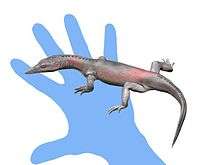Lazarussuchus
Lazarussuchus (meaning "Lazarus's crocodile") is a genus of basal choristodere, a type of amphibious reptile, known from France, Germany, and the Czech Republic. Fossils have been found in Late Paleocene, Late Oligocene, and Early Miocene deposits, meaning that the genus lasted about 40 million years. Two species have been named: the type species L. inexpectatus ("unexpected") (Hecht, 1992) from the late Oligocene of France and Germany[1] and L. dvoraki (for Zdeněk Dvořák) from the early Miocene of the Czech Republic.[2] It was not a large animal; the skull of L. inexpectatus was only about 4.53 centimeters long (1.78 in).[1] A complete specimen of Lazarussuchus with preserved soft tissue was found from the Late Paleocene of France, but has not been assigned to a species.[3]
| Lazarussuchus | |
|---|---|
 | |
| Reconstruction of L. inexpectatus | |
| Scientific classification | |
| Kingdom: | Animalia |
| Phylum: | Chordata |
| Class: | Reptilia |
| Order: | †Choristodera |
| Genus: | †Lazarussuchus Hecht, 1992 |
| Type species | |
| †Lazarussuchus inexpectatus Hecht, 1992 | |
| Other species | |
| |
Age and relationships
Lazarussuchus is the youngest member of the group Choristodera and the only choristodere to have lived after the Eocene. Choristoderes were once thought to have gone extinct at the start of the Eocene, possibly due to climatic changes happening at this time, known as the Paleocene-Eocene Thermal Maximum. The first known fossils of Lazarussuchus came from the Late Oligocene, meaning that it extended the fossil range of Choristodera by several million years. At the time of its discovery Lazarussuchus was considered an example of the Lazarus effect because its "unexpected" presence followed a long gap in the choristodere fossil record. However, older specimens of Lazarussuchus have been found that extend its fossil range to before the Eocene, closing the apparent gap in the record.[3]
Lazarussuchus was initially interpreted as the basalmost member of Choristodera, meaning that its lineage must have been the earliest to branch off from the group.[4] Since the first definitive choristoderes appear in the Middle Jurassic, the lineage represented by Lazarussuchus implied a very long ghost lineage of choristoderes spanning at least 100 million years.[2] The Lazarussuchus lineage may have been able to survive for such a long period of time and outlast all other choristodere lineages because they were small in size and had generalized, lizard-like body forms that enabled them to cope with environmental changes.[1] However, Matsumoto et al. (2013) places Cteniogenys, the oldest known choristodere, as the most basal member of the group and has Lazarussuchus in a more derived position within a clade of small-bodied choristoderes known mostly from the Early Cretaceous. This position significantly shortens the ghost lineage of Lazarussuchus, although there is still a gap between the disappearance of small-bodied, lizard-like choristoderes at the end of the Early Cretaceous and their reappearance in the form of Lazarussuchus in the Paleocene. Possible lizard-like choristoderes have been found in Late Cretaceous North American deposits, although their remains are very fragmentary.[3] The cladistic analysis of Coeruleodraco by Matsumoto et al. (2019) also found Lazarussuchus to be more derived than Cteniogenys or Coeruleodraco.[5]
References
- Hecht, M.K. (1992). "A new choristodere (Reptilia, Diapsida) from the Oligocene of France: an example of the Lazarus effect". Geobios. 25: 115–131. doi:10.1016/S0016-6995(09)90041-9.
- Evans, Susan E.; Klembara, Jozef (2005). "A choristoderan reptile (Reptilia: Diapsida) from the Lower Miocene of northwest Bohemia (Czech Republic)". Journal of Vertebrate Paleontology. 25 (1): 171–184. doi:10.1671/0272-4634(2005)025[0171:ACRRDF]2.0.CO;2. ISSN 0272-4634.
- Matsumoto, R.; Buffetaut, E.; Escuillie, F.; Hervet, S.; Evans, S. E. (2013). "New material of the choristodere Lazarussuchus (Diapsida, Choristodera) from the Paleocene of France". Journal of Vertebrate Paleontology. 33 (2): 319. doi:10.1080/02724634.2012.716274.
- Evans, S.E.; Hecht, M.K. (1993). "A history of an extinct reptilian clade, the Choristodera: longevity, Lazarus-Taxa, and the fossil record". Evolutionary Biology. 27: 323–338. doi:10.1007/978-1-4615-2878-4_8.
- Matsumoto, Ryoko; Dong, Liping; Wang, Yuan; Evans, Susan E. (2019). "The first record of a nearly complete choristodere (Reptilia: Diapsida) from the Upper Jurassic of Hebei Province, People's Republic of China". Journal of Systematic Palaeontology. 0 (0): 1–18. doi:10.1080/14772019.2018.1494220.
External links
- Ghost lineages - brief article on the fossil record of choristoderes

